The following exercises will be used in our VGK “Pause” Workout Program. After the first week, we will add new exercises to the list. Don’t forget to read the Tips at the bottom of the page. Any questions can be asked in the comments, or through email.
Table of Contents
Squats
- “Sit back” – make sure to move your butt backward, don’t just bend your knees. Your knees should be over your ankles and not pass your toes.
- Be careful to keep your knees in line with your toes, don’t let them cave in
- Don’t forget about your upper body – look straight ahead and don’t round your back. Keep your chest and head upright, looking forward.
- It helps to extend your arms for balance
- Refer to the pictures below (read caption for the first picture)
- Squeeze your butt on your way up for best results.

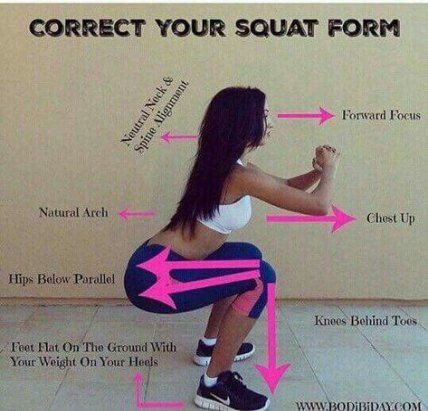
Planks
There are different variations of the plank. The picture below shows the position we will hold for just a normal plank. You can choose to keep your hands flat on the floor, rest your fists on their sides, or interlock your fingers; either way is acceptable.
- Start off in a push-up position, with your body up and your arms straight.
- One at a time, come down on your elbows, with your hands flat on the floor. Your elbows should be just outside the width of your shoulders. You should be in a straight line from your ears to ankles; don’t let your back arch or sag. Hold in the lifted position for the time indicated in each workout plan.
- Note: Can’t hold it? Do a modified plank, and let your knees rest on the floor (but still maintain that straight line from ears to knees). Or you can stay in the original position with your knees and elbows up, as if you are about to do a push-up.
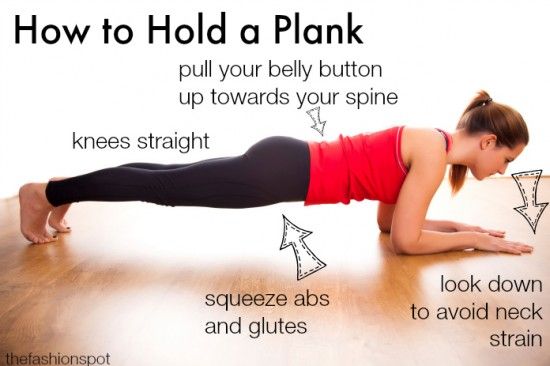
Lunges
Can be done by “walking” into the lunge position (as in, every lunge takes you a step forward), or simply alternating legs in place. Weights are not necessary.
Note: If you have issues with your knees, try doing reverse lunges. It’s the same position, but you are stepping backwards into it, instead of forwards.
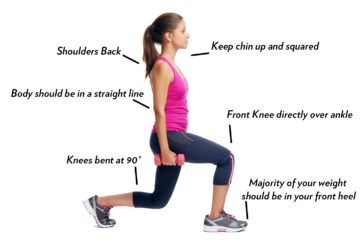
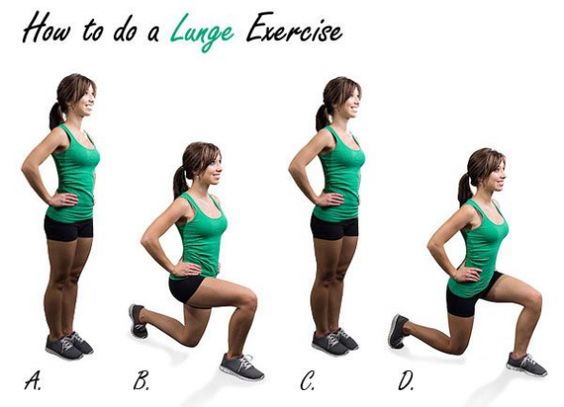
Standing Bicycle Crunches
Start standing with your feet together, hands clasped behind your head, elbows out to the sides. Shift your weight to your left leg, bend your right knee, and draw it up as high as you can to your chest as you turn your ribcage in toward your raised knee, drawing your left elbow to the outside of your right knee.
Slowly lower your leg back down and then repeat again on the same side.
Options: If it’s too hard to balance right away, practice these with your right hand against a wall to start.
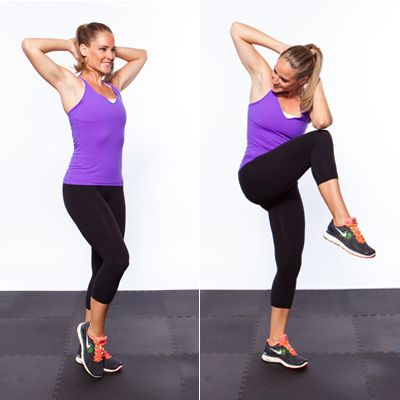
Wall Sit
- Stand with your back pressing against a wall.
- Slide downward into a squat position. The more you can get your thighs parallel to the floor and still hold the pose for the whole time, the better.
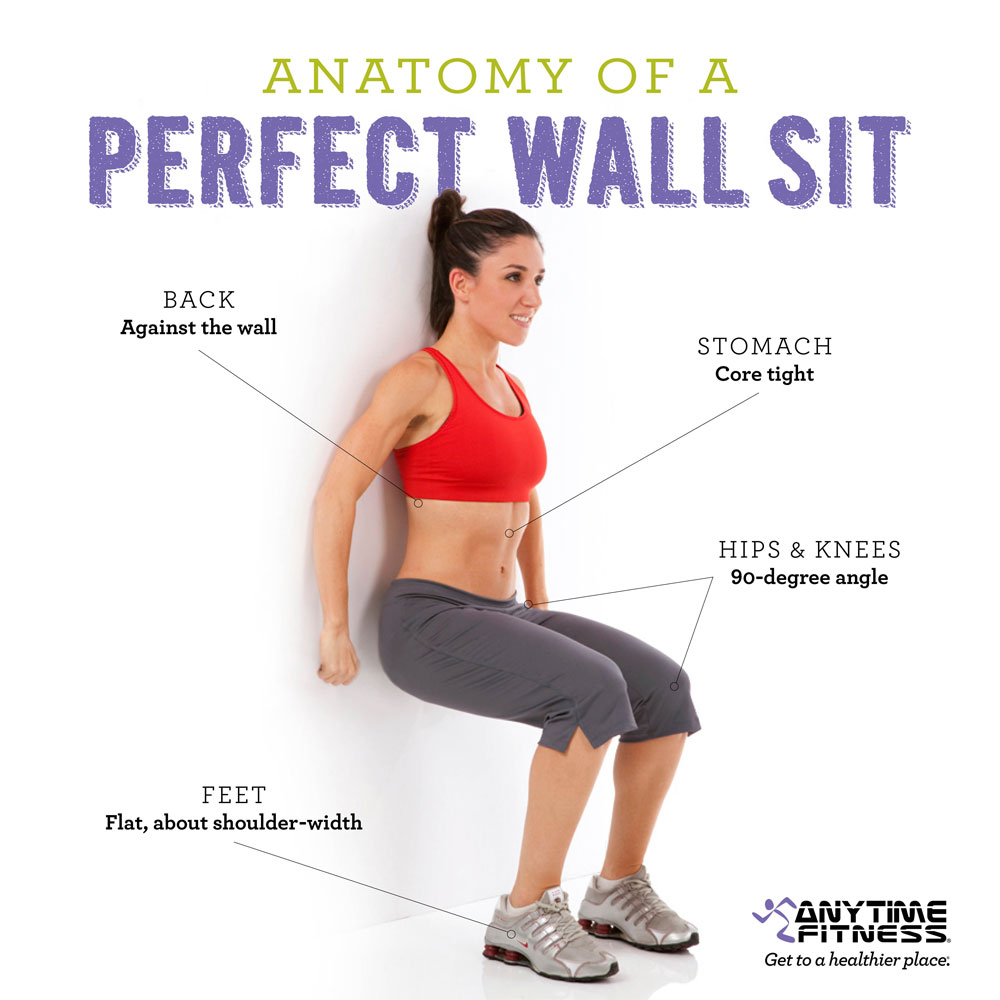
Push-Ups
It’s important to maintain proper form all the way through as you lower and raise your body back up, otherwise it could cause pain in your lower back.
- Begin with your hands just wider than your shoulders.
- Keep your neck and spine in a straight line. You want to imagine there is a line running straight down your body from the top of your head all the way down to your ankles.
- Lower down so your elbows go to 90 degrees, pause momentarily, then exhale as you tighten your tummy and lift yourself back up to starting position.
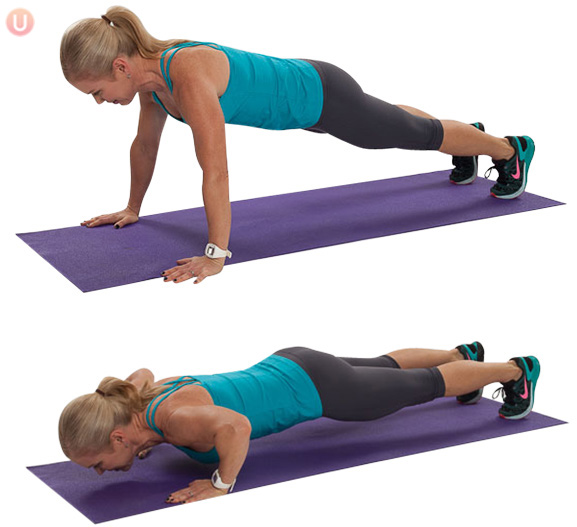
Modified Push-Ups
Instead of holding your weight up with your hands and feet at an incline, you’ll be on your hands and knees on the ground. Make sure to keep that straight line from ears to hips to knees at all times.
Note that your toes can rest on the floor, or you can keep your feet raised off the ground.
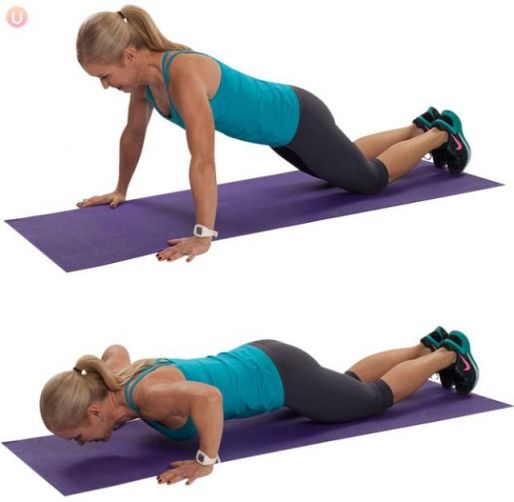
Butt Kicks
Start standing tall and bring one heel off the floor towards your glutes (butt), the opposite hand comes up towards you shoulder like running arms, then switch to the other side. Basically you are kicking your butt, without moving your thighs. This is meant to be done quickly, like you’re running in place. If you have trouble with your knees, do front kicks instead.
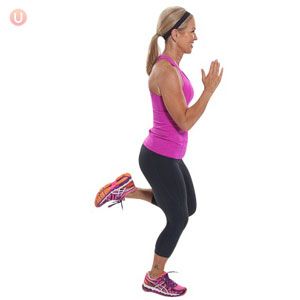
Front Kicks
Tighten your core and your glutes, lean back slightly, raise your thigh first (important) and kick out. Don’t just kick straight up from the ground. Bring your knee and thigh up first!
You should be sure to keep your kicks low until you feel sufficiently warmed up. If you kick too high, too soon, you may pull a hamstring. Once you feel warm, you can begin to move them higher and faster. Don’t be concerned with straightening your leg completely when you kick.
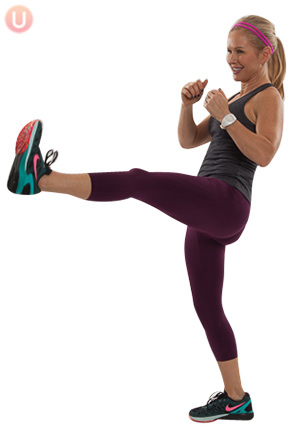
Glute Bridges
Follow the picture below, starting with your feet about as wide as your hips (or slightly wider). You feet should be placed so that when you raise your hips, your knees are directly over your ankles. You don’t want your feet too far away, or too close to your butt.
Tighten your abs and glutes before raising your hips off the floor. Only raise them until you have formed a straight line from your shoulders to your knees. Then lower back down, allow your hips to kiss the floor before raising back up. Keep your glutes and abs tight the entire time.

Jumping Jacks
Simply jump from the first position in the picture to the second position, all in one motion. Skip this exercise if you have bad knees or need low impact options.

Tips
- Definitions:
Reps– The number of times you do an exercise in one set (before resting). Sets– The number of cycles of reps you perform.
Example: Squats- 3 sets of 10 reps. This means you do 10 squats in a row before resting or moving on to a new exercise. Before you have completed your workout, you should have done those 10 squats 3 times.
- Don’t forget to BREATHE! Breathe in on the easy part of the exercise, and out on the difficult part. Ex: for a push-up, breathe in as you lower down, and out as you push up.
- Focus on keeping your abs and glutes tight to avoid injuries. It also helps to tighten your pelvic floor while exercising (like a Kegel).
- Exercise in front of a mirror. Without a mirror, you may not realize it when you don’t have proper form.
- Drink lots of water.
- Feel free to do more or less than what is listed in the workout plan. Pay attention to your body. You want it to be difficult, but not painful. If the workout calls for 10 reps, reps 8-10 should be fairly difficult to finish. If they’re not, do more. If you struggle with reps 5 and 6, do less. For the first week though, try not to do too many more reps than what is suggested.
3 thoughts on “Basic Bodyweight Exercises For Getting In Shape”
Comments are closed.